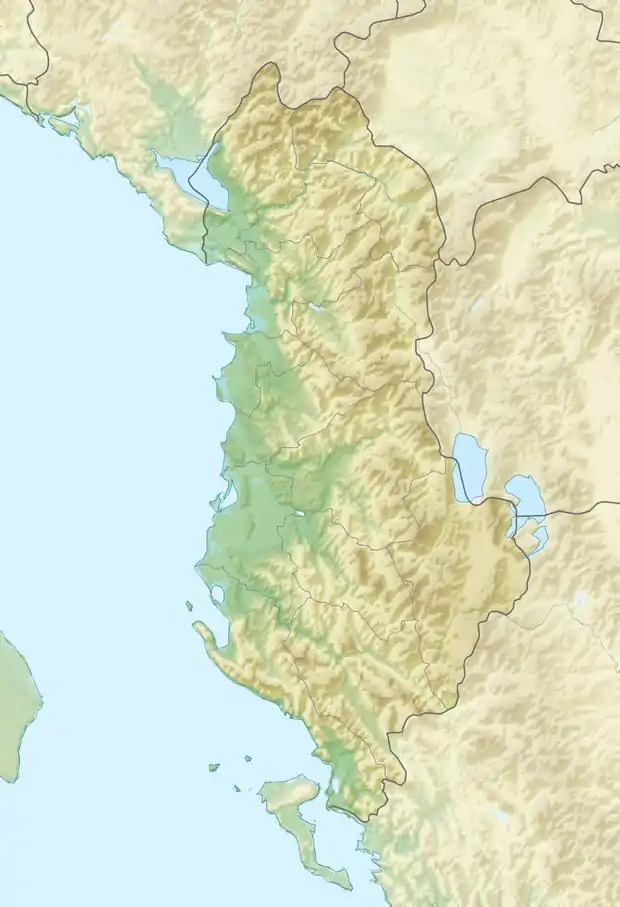Pilot (župa)
Pilot (Greek: Πολάθων, Church Slavonic: Пилоть, Latin: Polatum, Albanian: Pulati) was a Serbian province in medieval Albania (Greek Arbanon, Old Serbian Rabьn), approximately between the cities Shkodra in the west and Prizren in the east, and between the rivers Valbona in the north and the northern arm of the Drin in the south. Serbian king Stefan Nemanja conquered the region from Byzantium in 1190, along with the cities of Shkodra and Bar.[1] Later conquests by King Milutin and Emperor Stefan Dušan pushed the border further east and south, and Pilot remained within the Serbian empire until its fall in 1355 and the Ottoman conquest of Albania. Saint Sava and later sources distinguish an Upper and a Lower Pilot, separated by the Ndërmajna mountain.[2]

The name stems from Greek: Πολάθων, romanized: Polathon ("land of palaces"), a Greek Orthodox suffragan diocese of Dyrrhachion in the 9th century. In the 11th century, the Roman Catholic diocese of Polatum appears as a suffragan of Bar.[3] When the Serbian Orthodox Church became autocephalous in 1219, Pilot was divided into the Serbian dioceses Budimlje, Zeta, Hvosno and Prizren.[4] In the 14th century, the Roman Catholic diocese Polatum was divided into Polatum maior, having its seat in the Benedictine monastery of St Paul de Polato, and Polatum minor around Sarda. From the 15th century onwards, members of the Dushmani appear as Catholic bishops.
Illyricum sacrum (VII, 261-262) lists the following pagi as belonging to the Roman Catholic diocese of Polatum:[5]
- Polatum inferior (southern part):
The Serbian monasteries Hilandar, Dečani, and Prizren owned extensive estates (metochions) in Pilot. In the 14th century, the area was ripe with orthodox priests.[6]
Russian ambassador and historian Ivan Jastrebov (1839–1894) identified Pilot as the Dukagjin highlands.
See also
- Pult, village in northern Albania
- Diocese of Pulati, former Roman Catholic diocese
References
- Konstantin Jireček (1916), "Albanien in der Vergangenheit", Illyrisch-albanische Forschungen, 1, pp. 70–71
- Stojan Novaković (1877), "Zemljište radnje Nemanjine", Godišnjica Nikole Čupića, I: 208–212
- Ludwig Thalloczy; Konstantin Jireček (1916), "Zwei Urkunden aus Nordalbanien", Illyrisch-albanische Forschungen, 1, p. 128
- Miladin Bojić (1990), "Srbi i Srpska pravoslavna crkva u Arbaniji u doba Nemanjića (1166-1371)", Stanovništvo slovenskog porijekla u Albaniji - Zbornik radova sa međunarodnog naučnog skupa održanog na Cetinju 21, 22. i 23. juna 1990. godine
- Johann Georg von Hahn (1854), Albanesische Studien, p. 209
- Milan Šufflay (1916), "Die Kirchenzustände im vortürkischen Albanien", Illyrisch-albanische Forschungen, 1, p. 216, 232-233, 249
External links
- Malović-Đukić, Marica (1991). "Пилот у средњем веку". Становништво словенског поријекла у Албанији: Зборник радова са међународног научног скупа одржаног на Цетињу 21, 22. и 23. јуна 1990. године. Titograd: Историјски институт СР Црне Горе.CS1 maint: ref=harv (link)
